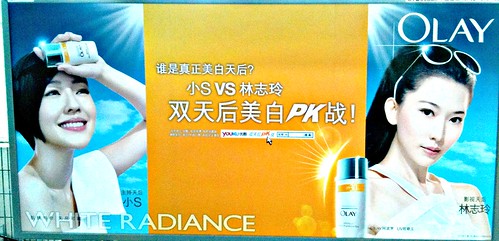Olay PK Ad
I think this is going to be one of Shanghai’s shortest springs ever; we’re practically going straight from winter to summer. And advertisers know it; I saw this ad for skin whitening cream on the Metro the other day:
What struck me about this ad was not the amount of English, but rather the diversity of its usage in the ad:
1. Olay: a famous brand name, untranslated. (This is kind of a ballsy move in China, but some companies do it.)
2. White Radiance: the product’s English name. This is probably mostly for aesthetic effect and symmetry of design.
3. 小S: a name. Yes, her Chinese name is 小S. It might not be her real name, but it’s her name.
4. VS: a term used pretty often in Chinese, appreciated for its simplicity and compact nature. (In Chinese, you spell it out: V-S.)
5. PK: a Chinese verb (derived from “player kill”) popular among the young internet-savvy folk, referring to some type of elimination competition.
The less interesting part is the actual content of the ad. It’s trying to get people to go to a website and vote for the star they think is whiter. Ugh.


Hehehe.. whitening products.. always makes me chuckle. 🙂
It’s also interesting that an ad in Shanghai features two celebrities from Taiwan.
Thanks for the post. Though most information is correct, it may not represent how Chinese actually use or understand this “English”. Being a native speaker of Chinese, my understanding is:
OLAY: Certainly it is a brand name, and it is phonetically translated and written as 歐蕾. When Chinese girls talk about its products, they pronounce “olay” more like in a Chinese than in an English way.
小S: This anchorwoman’s Chinese name is 徐熙娣, who has an older sister named 徐熙媛 and knows as 大S。大小S are the sisters’ stage names(藝名). Like most people with stage names in the west, 小S is well known and usually addressed by this nickname in public.
PK: This verb is usually used as “A 跟 B PK” in a sentence, or “PK戰” as a term in whole, like in the ad. Together with the previous “VS”, I believe they have an origin in Japanese video fighting games, and are widely spread by the use of Taiwanese subculture and media.
And your conclusion is absolutely right — no body would like to have a (silly) vote online, except employees of the ad company 🙂
Clearly 林志玲 is the whiter one. Or maybe its just the lighting from your camera? 小S just looks blue.
More to the point, why are these two Casper-white “beauties” exposed to the aging rays of the sun directly, without an umbrella? At least Xiao S is attempting to shield herself with a bottle of the product, ineffective as that may be.
It took me a while to figure out what PK meant in Mandarin. Even now when I see it I always think of 仆街 (puk gaai) first.
PK战 makes me imagine that they’re going to settle this debate with a penalty shootout.
@David, PK still means what you think it means, even in Manadrin
有中國特色的英文同漢字的混合書寫……